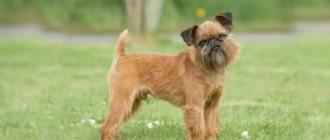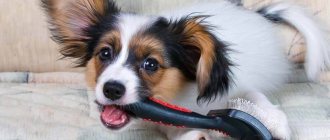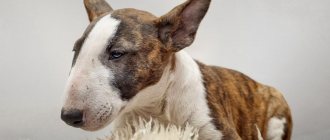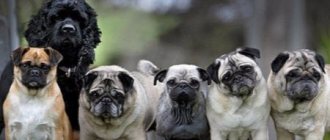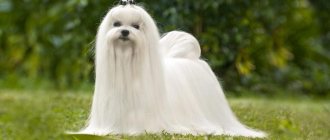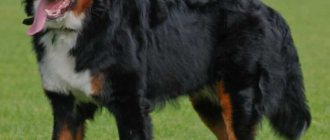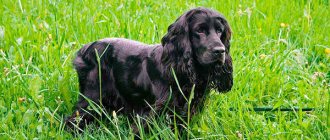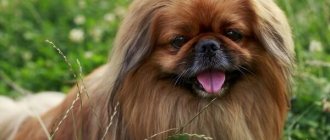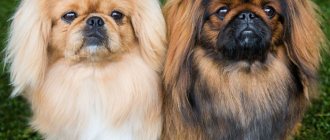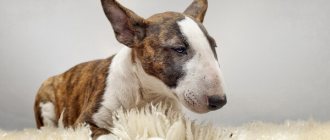Have you ever fallen in love with a handsome guy with a beard? What about the little lady with a thick bush of hair on her chin? We're talking about dogs, of course! And they don't just need these beards to look cute. It turns out that most bearded dogs were bred to hunt small game such as rodents, mice and burrowing animals. The beards protected their muzzles from animal bites, as well as from thorns, branches and anything else that a fearless dog might encounter while hunting.
Let's take a look at some of the most famous dog breeds with beards, as well as what it takes to care for those wonderful chin hairs.
Belgian Griffon
Small, playful dogs with a slightly curved forehead, short muzzle and wide skull were bred in Belgium around 1800. Griffons are great companions that require constant mental and physical stimulation. They are somewhat stubborn and picky and cannot tolerate small children of any age. Some males have an increased appetite, so carefully monitor their diet and do not leave food freely available. Clean your thick mustache and drooping beard daily from food debris and any dirt, and comb it. Periodically trim any excess hair that gets into the corners of your eyes to avoid irritation. The optimal number of walks per day is 2-3. After going outside, be sure to wash your paws and undercoat with a special shampoo.
Belgian griffin
Newfoundland
Another black giant of the dog world. The breed was bred to assist in search and rescue missions, but the diver can also be an excellent guard dog. The body of the animal is dense, the head is large. He is highly trainable and extremely loyal to his owner. The Newfoundland coat has its own characteristics - a black, unusually thick, oily double undercoat, which allows the animal to feel comfortable in the water.
Representatives of this breed are by nature lumps who prefer to rest for hours. Therefore, it is very important to give them exercise periodically to avoid problems with excess weight and health.
Giant Schnauzer
The Giant Schnauzer is a large, powerful animal with a rectangular elongated muzzle, a round black nose, egg-shaped eyes, thick eyebrows, a characteristic neat beard and drooping mustache. This breed is incredibly energetic, restless, and in some situations can become aggressive. Therefore, in a house where there are infants or children under 10 years old, it is not recommended to have such a pet. These dogs need long daily exercise walks with intense exercise lasting 40 minutes or more, regardless of the weather. Very often, Giant Schnauzers are used as yard watchmen. Approximately 2-3 times a week requires thorough cleaning with a stiff bristle brush. Wash your face after every meal. Trim the claws as they grow. A professional haircut is required at least 4 times a year. Organize a proper and balanced diet in consultation with your veterinarian.
Giant Schnauzer
Rottweiler
According to the standard, this breed is not completely black; there are red areas on the chest and face of the animal. The Rottweiler's build is stocky and muscular. The breed was originally bred to transport small loads, but now this dog serves as a guard. He is very jealous of his territory and is wary of strangers.
Read TOP 20 kindest dogs in the world
The coat is very thick and short, requiring no special care. Due to their thick undercoat, they tolerate cold well. Dogs of this breed must be trained, and this should be done by professionals. An untrained Rottweiler can pose a threat even to its owners.
Bearded Collie
The Bearded Collie, Birdie, or Bearded Collie is the oldest English breed, created in Scotland. These dogs have a medium but muscular build, a wide head, slanting coal-black eyes, and thick long hair that hangs slightly from the chin. The height of an adult is about 70 cm, so when feeding, you will need a bowl for bearded dogs on a stand to make it easier for the animal to reach. Be sure to include veal and beef liver in your diet for healthy joints. Birdie is distinguished by intellectual abilities, courage and gentleness of character. She shows kindness, affection and devotion, and is loyal to children and strangers. Approximately 1 hour a day should be devoted to training at specialized sites. Bearded men need periodic haircuts once a month, as well as daily brushing of the coat using hypoallergenic cosmetics.
Collie
Herding breeds
Bearded dogs are found among long-haired shepherd dogs. The hair on the body and head grows almost the same length. Hair growth above the eyes, on the cheeks, cheekbones and chin forms a thick beard, bangs hiding the eyes, and a bushy mustache.
Catalan Shepherd
These are the first Spanish dogs to gain worldwide recognition. At home, they became skilled assistants to farmers. Catalan Shepherds are famous for their independent thinking and ingenuity; they are able to manage a herd for a long time without the presence of a person.
Portuguese Shepherd
The dogs were bred in the Alentejo region of Portugal, where they still help herd and guard livestock. In their homeland, the animals’ facial expressions are seen to have a subtle resemblance to a monkey, which is why they are jokingly called “monkey dog.”
South Russian Shepherd
The animals look like huge shaggy lap dogs of white, light gray, fawn color. The length of the fur reaches 20 cm, and is almost the same size on the body and head. If you do not plan to take your pet to exhibitions, then the fur coat is trimmed to 5 cm.
Bouvier des Flanders
The literal translation of the name is “shepherd from Flanders.” According to the requirements of the standard, a mustache and a hard, heavy beard “should impart ferocity to the expression.”
Bearded Collie
Antique Scottish Cattle Dogs are medium sized. The name was given for the lush long hair all over the head and on the chin. Animals exhibit a curious property. Puppies are born dark. As they grow older, the hair lightens, and permanent color is formed only at 3 years.
Lhasa apso
The Lhasa Apso, or Lhasa, is a Tibetan guard variety with a lush, porous coat covering the entire body, with hanging ears and a tail slightly raised up. Lhasa is independent, capricious, hardy and moderately energetic. Such a pet treats other pets calmly and does not offend small children. Lhasa Apsos require periodic visits to the dentist to remove tartar and plaque. Take your dog to a professional groomer monthly for thorough care of unruly fur. After a walk, bathe the animal, washing away dirt with a soft brush. Walk your pet 2-3 times a day. If you find dirt in the ears, remove it with a cotton swab soaked in a solution of Chlorhexidine or chamomile decoction.
Lhasa apso
Basic content rules
The rules for keeping bearded dogs are no different from the principles of caring for any other animals. Mandatory care measures include:
- control over the diet (it can consist of both ready-made mixtures and natural products);
- arrangement of a place for the dog (with a bed and bowls for water and food);
- hygiene procedures (bathing, brushing, cleaning eyes and ears, trimming nails);
- medical procedures (regular preventive examinations at the veterinarian and vaccinations).
An important feature of keeping bearded dogs is associated with the physiological characteristics of the animal, in particular, with non-standard hair. It is in relation to grooming that the animal needs additional measures that are not required in the process of caring for other types of dogs.
This applies to daily combing using special combs and brushes. Under no circumstances should tufts be allowed to form on the fur. In addition, be sure to groom (cut) the coat. To do this, contact specialists. Such care activities will not only ensure your pet’s neat and well-groomed appearance, but also its health.
Irish Wolfhound
The Irish Wolfhound is a hunting breed first bred by the ancient Celts. Its distinctive features are: a muscular large body, a long elongated head with a pointed muzzle, small ears, soft curly fur of gray, white or black color. This dog is not designed for apartments; it requires a large free space for outdoor games. Spend at least 50 minutes a day walking and exercising. Starting from early puppyhood (from 3 months), train your pet so that in the future he will be kind and socialized. The wolfhound is smart, brave and sensitive, and with proper upbringing, it is friendly to children and other pets. It should be trimmed twice a year. Clean your ears periodically. The diet can include both dry food and natural products.
Irish Wolfhound
Results
Once you have decided what breed of dog you want, the next step is to find a verified official kennel that breeds that breed. In addition, you can look for a breeder. When purchasing, you need to look at all the documents he has to confirm the purebred and health of the puppy.
IMPORTANT! When choosing a puppy, look at its behavior and appearance. The puppy must be very inquisitive, active and well-groomed.
Source
Lakeland Terrier
Lakeland Terriers appeared in England in the 17th century. They have a medium body size (up to 40 cm at the withers), curly light brown hair, an elongated muzzle with a curly beard. These pets love to bark loudly, both when threatened and when they are happy. Lakelands treat all family members equally, in some situations they can be amicable, and are easy to train. They need professional training and socialization, daily morning walks, and monthly coat trimming. Every day, wipe your eyes with chamomile infusion and cleanse your ears of wax. Trim the claws as they grow. Feed your pet fresh cottage cheese, boiled sea fish and beef, adding balanced dry mixtures to the menu.
Lakeland Terrier
Character traits
The Bearded Collie is ideal for families with children and for active owners. He is sociable, loyal, very attached to his owner and all family members, and is ready to be with them all the time. He has a hard time with separation and is very bored when alone. He loves children and treats them with care. Can play with a child all day long, not forgetting to herd and protect him. This dog is capable of becoming a good nanny, as he never offends children and treats them with care.
Birdies are friendly and peaceful. They can get along with any people and adapt to their habits. Despite their developed guard qualities, these dogs do not show aggression towards strangers, they are friendly and sociable. They get along well with any pets at home. He tries to shepherd everyone - to gather them all in one place.
This is an active, cheerful dog. She loves to run, play, and is good at learning any tricks. This is a good companion for active recreation and travel. The dog retains its playfulness and energy until old age.
Biardid has a calm, balanced character. Dogs do not show nervousness or irritability. Although, due to their very sensitive hearing, they can be frightened by loud sounds. Proper socialization is necessary to wean your pet from this.
Education and training
These dogs are very smart and quick-witted, they learn commands quickly and are good at learning tricks. They love to learn something new, are curious, but are stubborn and independent, and are prone to making independent decisions. Therefore, they may not always immediately execute commands. For a dog to be obedient, it needs education from an early age and proper socialization.
An experienced dog breeder will achieve the best success in training. The owner must gain authority from the pet. He must have a strong-willed character. You cannot give your dog any concessions, allow liberties and disobedience. But under no circumstances should you punish physically or shout rudely - birdies are touchy. When training, you need to adhere to several rules:
- classes must be consistent and regular;
- communicate with the dog patiently and calmly;
- give commands firmly, confidently, in an even voice;
- training needs to be varied and carried out in the form of a game;
- Be sure to use encouragement - affection, treats.
It is necessary to start education from an early age. After the puppy arrives in its new home, you need to teach it to respond to its name and come on command. They immediately accustom him to a place, a toilet, a leash, and a routine. It is necessary to study the basic commands: “near”, “stand”, “sit”, “no”. If the owner does not have experience in raising dogs, at 5-6 months it is better to contact a dog trainer for a General training course.
Interesting pictures illustrate the behavior of these dogs:
Polish Lowland Sheepdog
The Polish Lowland Shepherd is the oldest member of the Canidae family, with thick fur, a rounded muzzle and powerful, dense paws. These animals are kind, loyal and friendly, they love active activities and games, and when alone they can become very bored and sad. They are ideal for yard keeping. Due to its voluminous coat, the Polish Shepherd requires careful care: constantly comb and wash your pet, periodically visiting the groomer. Do not overfeed your pet, as this breed is prone to obesity. Create a three-course menu with vitamin and mineral supplements for proper and healthy development.
Polish Lowland Sheepdog
Swedish Lapphund
The Lapphund bears some resemblance to a wolf, with small triangular ears slightly rounded at the tips, and a tail curled over the back. This is a strong dog with a solid build, capable of thriving in any type of terrain, especially in the mountains and in the water. The dog's coat is resistant to weather conditions.
The dog is medium in size (48 cm for the male and 43 cm for the female). The body fits into a rectangle whose length is slightly greater than its height. The eyes are expressive, round and dark brown. His gait is wide and light. The fur consists of abundant straight and coarse hair, longer at the level of the chest, tail and back of the limbs. The undercoat is very soft, dense and finely curly.
Smart, agile, brave and cheerful, the Lapphund loves to work and please his owner. He is a versatile and expressive dog. Lapphund requires a solid and consistent education (especially the first year of training). He learns very easily and can excel in many disciplines such as agility, obedience, tracking or even waterwork.
The Swedish dog is a rare breed due to its numbers, but it deserves interest, in particular due to its training abilities, its watchdog qualities, but above all because it is a charming companion for the whole family!
Miniature Schnauzer
The miniature schnauzer is a semi-dwarf graceful dog (height at the withers 35-40 cm) with a shaggy elongated muzzle and black almond-shaped eyes. Its color is varied: from light beige to ash-gray. Average life expectancy is 10-15 years. Kindness, loyalty, tenderness, activity, friendliness are the main character traits inherent in these sweetest creatures. When walking in an unfenced area, try not to let your pet off the leash, otherwise he may run away. The peculiarity of the coat is that it does not shed. But still, a haircut is required every 5-7 weeks. Wash your beard immediately after eating. Shorten your nails 2-3 times a month. Periodically pluck the hairs in the area of the ears and eye sockets. The optimal diet for schnauzers should consist of foods that support vital energy: proteins and carbohydrates. The amount of feeding per day for an adult is 3-4 times.
Miniature Schnauzer
Neapolitan Mastiff
Comes from the oldest families of dogs and was a companion of Alexander the Great, as well as Cyrus and the Phoenician sailors. For a long time he enlivened the arenas of the Colosseum in Rome. Despite the fall of the Roman Empire, he remained guardian of the villas in southern Italy. Saved from extinction at least, it was only in 1946 that he began to be seen at exhibitions.
The Neapolitan Mastiff, a breed of Italian origin, is a powerful mastiff of impressive build with a massive, broad head and short muzzle - this is the image of a mastiff.
This wrinkled face with a well-defined square shape remains very characteristic of the Neapolitan Mastiff breed. Its well-built body is covered with short hair, the color of which ranges from fawn to black through various shades of gray.
Sturdy, rustic, imposing, this is an excellent guard dog, but also a good family companion, although it enjoys dominating its companions.
He needs exercise and is not content with a living space that is too small. Early education can only help the good integration of this companion, whose guarding instinct is innate and sufficient. The Neapolitan Mastiff needs to be exercised and cannot be kept indoors for too long.
Shih Tzu
The Shih Tzu, or chrysanthemum dog, is a small, neat animal with long, smooth fur. These are affectionate and devoted creatures, indifferent to other pets, preferring the company of their owner. The Shih Tzu's personality is fiery and playful. Correct training will require professional lessons with a trainer, walks on a short leash and learning commands at home. Start lessons from 4 months of birth. To prevent the formation of tangles and knots on the hair, comb the hair several times a day with semi-hard bristles. Bathe no more than once a month. Chrysanthemums are prone to plumpness, so optimize the amount of food - no more than 4 times a day in small portions. Introduce offal (liver, hearts and ventricles), boiled turkey and rabbit meat into your diet.
Shih Tzu
Skye Terrier
The Skye Terrier is a short, bearded breed (up to 24 cm at the withers), first bred on the island of the same name, located off the coast of Scotland. Distinctive features: dense muscular body, round brown eyes and pointed ears. The color can be anything: from white to black. These pets are suitable for sharing with older children who understand the basics of interacting with an animal. After all, Skye Terriers do not accept disrespect for personal space, assertiveness and annoyingness. They decide for themselves when they are ready to communicate. Walk for at least 30 minutes every day. At home, equip a special bed in the place your pet chooses. Do not have other domestic animals indoors, otherwise they will become a source of prey. Bathe your dog at least 2 times a week using special hypoallergenic shampoos.
Skye Terrier
German dog
Aristocrat of the dog world. Great Danes are one of the tallest dog breeds at the withers. A wonderful security guard and bodyguard, full of dignity. It never barks in vain, and does not show aggression towards strangers without the owner’s command.
Like the Cane Corso, the Great Dane is a short-haired dog that does not tolerate cold well. The dog's coat is shiny and very dense. It is united with the “Corsican dog” by a common ancestor – the Tibetan mastiff. Despite its impressive appearance, this dog is not aggressive; it is almost invisible in the house, which is why it received the nickname “inconspicuous dog.”
Miniature Schnauzer
The Miniature Schnauzer, or Mittel, is an intelligent, but slightly stubborn protector and loyal friend. They choose and recognize only one owner, but treat other family members with respect. Aggression occurs extremely rarely: usually when meeting another dog on the street. Never shout or offend the animal, otherwise the animal will stop trusting you. For harmonious development, take your pet to an equipped area every day. Wash your paws and trim your beard regularly. Miniature schnauzers love swimming, so if possible, organize trips to a specialized pool, and in the summer to a local pond.
Miniature Schnauzer
Choosing a puppy
The Russian population of bearded collies is quite small; there are only a few nurseries specializing in their breeding. You only need to buy a puppy there and you will have to reserve your pet in advance. The breeder is obliged to provide the future owner with a puppy card, a veterinary book with vaccination records, copies of the parents' pedigrees, a breeding patent, a purchase and sale agreement and other documents.
Small bearded dogs are completely different from their parents, so they can be easily confused with many other purebred and outbred dogs. To understand all the nuances, you need a lot of experience, so it is better to seek help from a professional dog handler.
Biardid puppies look little like their parents
Price of a puppy of this breed
The cost of shaggy collie puppies varies from 30 to 65 thousand rubles. The specific amount is determined by the title of the parent couple, the prospects of the pet, its health, external data and other parameters.
Birdies are not a commercial breed, so advertisements for free sale are very rare. If one appears, and even at an attractive price, then this is a reason to suspect fraud.
Many years ago, in much the same way, we took an allegedly purebred German Shepherd puppy from a good person for almost nothing. The dog was taken for protection, but it was just right to protect it itself. She was frightened by any noise and hid in the farthest corner, but no one ever offended her, much less beat her. Cowardice turned out to be innate, coupled with the habit of chasing one’s own tail, which as a result of these exercises quickly lost its fur. Dealing with all this turned out to be extremely difficult and troublesome.
Drathaar
The Drathaar, or wirehaired German pointer, is a type of hunting dog developed in Germany in the late 19th century. Endurance, friendliness and obedience are the main character traits of the animal. German Drahthaars love small children, active games and under no circumstances show aggression towards strangers. A suburban area is ideal for keeping this breed, allowing for constant physical activity for the pet. Basic coat care: bathe twice a week, comb and trim once every 3 months. In the spring and summer, treat the undercoat with antiparasitic compounds, for example, Frontline. Drathaars are very fond of boiled buckwheat or millet cereals, beef and quail eggs.
Drathaar
Hunting dogs with beard
Thick, elongated hair grows on the chin in wirehaired pointers. The body is covered with short, close-lying hair. Against such a background, the beard on the muzzle is very noticeable.
Here are striking examples of bearded cops:
- Griffon Korthals. French breed, another name is the French Wirehaired Pointer.
The dogs were named after the first breeder, the Dutchman Eduard Kortal.
- Italian spinone. Researchers of the breed claim that the Spinone has never bitten anyone.
The Italian Spinone is equally adept at hunting on water and on land.
- Drathaar. The cops come from Germany.
Drathaar means “wool like wire” in German.
- The Czech fousek is very similar in appearance to the drathaar, sometimes even dog handlers confuse them.
Czech fuosek.
When talking about bearded hunting dogs, one cannot help but remember the dachshund. The breed breeds animals with three types of coat. Smooth-haired and long-haired species are devoid of hair on the face. The wire-haired dachshund has a distinct beard and eyebrows, although the body has coarse hair that lies close to the body.
Wire-haired dachshund.
Irish Blue Terrier
The Irish Blue Terrier, or Kerry Blue, is an elegant, stately dog with soft curly hair, a funny long beard and bushy eyebrows. Distinctive features: stubbornness, attentiveness, excellent attitude towards children. Be sure to be strict when training, otherwise the Kerry Blue may become willful and show character. Remember the basic rule of communicating with a blue terrier: never shout or raise your hand at the animal. Otherwise, you risk losing full contact with your “true friend.” The coat of these dogs is single-layer, so it practically does not shed. The main thing is to teach your pet to go to the groomer from puppyhood. There are no special instructions regarding catering. The number of feedings is 4 times a day.
Irish Blue Terrier
Schnauzers
The beard, mustache and bangs are the “calling card” of the Schnauzer. The family includes 3 independent, outwardly similar breeds. They were bred in Germany, but each has its own selection path, character, size:
The hard coat of Schnauzers does not shed on its own, so it is regularly plucked. Show dogs are clipped on the back and sides. A “skirt” is left along the bottom of the body and on the paws. The beard and mustache are not shortened much, but only trimmed along the edge.
Schnauzers have earned a reputation as highly trainable, non-argumentative animals with versatile abilities. They serve in the army, police, and work as personal bodyguards. They take prizes in canine sports. Schnauzer puppies grow into loyal companions and family pets.
Affenpinscher
The difficult to train, disheveled Affenpinscher is an old European breed. It began to be started in the mid-18th century. A long beard, drooping ears, short stature (up to 25 cm), a coal-black undercoat, and a high tail are the features that distinguish this dog. Affenpinschers are inquisitive and smart. They guard their own property (for example, toys) with special vigilance, so it will be quite difficult for them to get along in the same apartment with small children. Regularly trim the hairs growing near your eyes. Take daily long walks with outdoor games (running for a stick, frisbee or ball). Trim claws once every 4 weeks. Brush your teeth with a special brush.
Affenpinscher
The most intelligent, beautiful and unusual breeds of bearded dogs were described in this article. Protect, care and protect your pet, and then he will reciprocate your feelings. If you have any controversial issues with the organization of care and nutrition, we recommend that you contact your veterinarian.
Airedale
The Airedale Terrier is often called the "King of Terriers". This is partly due to their size - they are the largest of all terrier breeds. This is also due to their regal appearance and temperament. These dogs are incredibly intelligent, adaptable, have a lot of energy and stamina, and are full of character.
Their strong personality means that a novice dog owner may find the Airedale Terrier in a quandary. They can be independent and can have a stubborn streak; You definitely won’t be able to fit a helpful lapdog in this dog.
Like many terriers, the Airedale has a strong prey drive, and you may have to work hard to train your dog to use commands. This also means that they are not best suited for households with other small animals.
The Airedale Terrier's hard, wiry, and dense topcoat is easy to care for, although their coat will occasionally need striping to keep it from looking unruly. They also grow more hair around their face, giving them a very defined beard.
Be prepared for your fur to absorb a lot of water and dirt. May require a good cleaning and drying after a wet walk or even a bath!
